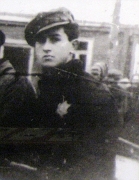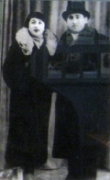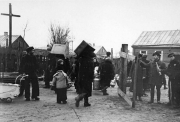|
Dear Wolf,
|
|
| |
|
 |
|
14-year-old Abe Malnik next to Kovno Ghetto
fence, 1941 |
|
| |
|
It was
wonderful hearing from you. I often think of you and our
meeting at the IX Forte during my first trip to Lithuania. You
mentioned in your letter that I seemed amazed to learn about
your childhood experience in the Hitler Youth and your father’s
Nazi past. You read me right; it was an incredible experience
for me, as most non-Jewish Europeans I’ve met that lived during
the Holocaust not only deny any familial affiliation with or
support for the Nazi movement, but also claim they were unaware
of the mass murder of 11 million people that was occurring
within their own cities, villages, and towns. I’m sorry I
didn’t have the opportunity to tell you about my family, but,
since it may be quite a while until we meet again, I will put it
in writing.
|
|
|
 |
|
Feiga & Josef (Kalman) Malnik |
|
|
| |
|
My father
lived in Kaunas (Kovno), Lithuania, with his parents,
grandparents, aunts, uncles, and cousins. When the Nazis turned
Kaunas into a ghetto, he was 14 years old and was forced, with
other Jewish prisoners, to build the ghetto fence that enclosed
approximately 30,000 Kaunas Jews. He and his family were
imprisoned there for the next couple of years until the Great
Action massacre when, on October 28, 1941, over 9,000 Kaunas
ghetto Jews were marched to the IX Forte, shot, and buried in
mass graves. Due to my grandfather’s bravery, my father and
grandparents escaped the slaughter, but the rest of our family
was among the thousands that perished. When the Nazis
subsequently liquidated the Kaunas ghetto, most of the Jews were
transported to concentration camps. My father and his parents
were sent to Stutthof concentration camp, where my grandmother
was separated during the selection process and was never heard
from again. Over the next two years, my father and grandfather,
together, were transported to four more concentration camps: Lietmeritz, Flossenberg, Dachau, and Theresienstadt, where they
were liberated. With train cars filled with retreating German
troops, my father, grandfather, and thousands more survivors
jumped and rode on top of the train cars headed to the Displaced
Persons Camp in Landsberg, Germany. Many fell to their deaths
before reaching complete freedom.
|
|
| |
|
 |
|
Abe Malnik helping build the
Kovno Ghetto fence, 1941 |
|
| |
|
My mother
is from Antwerp, Belgium, where she lived with her mother,
brother, and sister. When she was 13 years old, she went
into hiding for approximately two years with her Aunt and
Uncle in Brussels, until she was reported to the Gestapo by
a neighbor, was arrested and transported by truck to a
Calvary Post in Malines, Belgium, and forced into a cattle
car transport to Auschwitz/Birkenau. She was assigned to
forced labor for several months, then reassigned to kitchen
duty, during which time she was confronted and threatened by
the “Dr. of Death,” Joseph Mengele. Her mother and siblings
were also arrested and transported to Auschwitz/Birkenau and
were never heard from again. After approximately one year
in Auschwitz/Birkenau, as the allied troops were making
headway, my mother was one of millions of prisoners forced
on a “Death March,” as the Nazis evacuated the concentration
camps and killing centers to hide evidence of their
atrocities, while planning to utilize the prisoners for
their continued war effort. Several weeks later my mother
arrived in Bergen Belsen concentration camp, where she was
imprisoned for six months until her liberation.
Among the
hundreds of Holocaust documents I have obtained from various
sources, two are from the Red Cross Archives in Bad Arolsen,
dated May 28 and 29, 1944. Written on these documents are:
Birkenau and Der Lagerarzt KL Auschwitz II An das
Hygiene-Institute der Waffen-SS und Polizei, Anbei Werden
Rachenabatriche Untersuchung auf Diphtherie engesand t u. zw.
The documents are signed by SS Obersturmfuhrer Frauenlager. On
these documents are listed 112 prisoners, including my mother. Next to each name is a number that was tattooed on each
prisoner’s arm for tracking and identification. My mother is
listed twice—in position 4 on the first document, and position
82 on the second. Instead of being branded with one tattoo, my
mother was branded twice. The Nazis erred while processing her
transport, so, in keeping with the organized and methodical
system of the “Final Solution,” they tattooed a line through the
first tattooed number and replaced it with another. She bares
both numbers to this day.
After the war,
my parents immigrated to the United States where they met and
were married. Thanks to the invaluable training my father
received from ORT, he worked as an automobile mechanic for many
years and eventually became a successful businessman. My
parents had three sons (I am the youngest), made a comfortable
life for their family, and made many friends, including several
survivors—survivors who formed a close-knit group, shared
similar experiences of loss and survival, and talked about their
desires to educate people about the Holocaust to safeguard
future generations.
In the 1960’s
the survivors formed a social and charitable organization called
Club Shalom, of which my father was president for a time. In
addition to raising funds for Jewish communities and Israel, the
Club formed a Speaker’s Bureau that worked with high schools,
churches, synagogues, and universities, to provide a platform
for survivors to give their audiences first-hand accounts of the
Holocaust and warn them that genocide will continue to strike
anytime and anywhere unless educational and preventative
measures were taken. The Bureau continues to fulfill its
mission today through its affiliation with the United States
Holocaust Memorial Museum in Washington, DC. The Museum also
has a Committee on Conscience that creates Museum exhibits that
inform the public about regions where genocide is occurring or
likely to occur. The current exhibit is entitled, Genocide
Emergency—Darfur, Sudan: Who Will Survive Today?
In 1995, my
father had another opportunity to serve the public when the
United States Justice Department contacted him to testify as a
key witness against a former Lithuanian guard and Nazi
collaborator, Jonas Stelmokas, who headed the battalion that
massacred the Jewish prisoners at the IX Forte. The Justice
Department had recently arrested Stelmokas, who had been working
as an architect in Philadelphia, Pennsylvania, where the trial
was to be held. My father agreed to testify, and I went with
him to provide emotional support. During the first several days
of the trial, we watched and listened as Robert Seasonwein,
Michael Macqueen, and Denise Slavin, from the Office of Special
Investigations of the United States Justice Department, made
their case. Afterward, my father and another survivor were
called to testify. They spoke of how the Nazis ordered all the
Kaunas ghetto prisoners to report to the main square at
Democracy Plaza (within the ghetto), and how they selected and
separated over 9,000 of those prisoners, including themselves
and their families. My father continued by telling of the
escape he and his grandparents made just before the selected
prisoners were marched to the IX Forte, slaughtered, and buried
in mass graves. After their long, detailed, and disturbing
testimonies were heard, a visibly shaken Judge Dubois abruptly
called for a recess and exited the courtroom. As a result of
that trial, Jonas Stelmokas was stripped of his U.S. citizenship
and given orders for deportation. After you and I met, I gave
copies of the trial transcripts to the IX Forte Director, Julija
Menciuniene.
Sadly, my
father passed away last April. But his memory lives on, as I
carry on his zest for life and his spiritual connection to our
family that was lost in the Holocaust. Shortly before he
passed, my wife and I spoke with him about our plans to visit
Kaunas to continue three of his important, yet unfinished,
missions. The first was to locate the lost grave of his young
brother, Simon, who, on December 30, 1936, was tragically struck
and killed by a bus while crossing Luksio Street in Kaunas. The
second was to continue a charitable project he and his friend,
Max Reznik, started that sends donated funds to Kaunas' 400
Holocaust survivors and their descendants who live in poverty
and isolation. And the third mission was to try to locate
documentation that proves my family’s longstanding Lithuanian
citizenship and identifies our family’s property that was
confiscated and stolen by the Nazis and their Lithuanian
collaborators. It was during my first “mission” trip to Kaunas
that you and I met.
During my trip
to Lithuania, I met many fascinating and influential people,
visited my family’s former Kaunas home across from the former
Presidential Palace, and located the barber/beauty shop (kirpykla)
my grandparents owned at Luksio 20. I also discovered my
family’s property deeds and titles, tax records, passports, and
birth and death certificates that date back to 1906—all
documentation my father attempted to locate for 60 years through
the Lithuanian government and other sources. I felt I had
returned “home.” Unfortunately, though most of those experiences
were positive, a very unsettling incident occurred during my
attempt to find my uncle’s gravesite in the Kaunas Jewish
Cemetery. As I searched through the cemetery full of shattered
and desecrated headstones, and empty spaces where stolen
headstones previously marked the graves, I witnessed several
Lithuanians taking their dogs to urinate and defecate on the
cemetery grounds. My parents had seen the same deplorable acts
when they visited the cemetery ten years ago. Considering the
Lithuanians’ collaboration with the Nazis during the Holocaust,
such indecent and blatant disregard for the Jewish deceased not
only demonstrates a lack of moral decency, it may also serve as
a symbol of their nationwide resistance against accepting
responsibility for their crimes.
Prior to the
Holocaust, approximately 200,000 Jews lived in Lithuania. Today,
there remain approximately 3,000 in Vilnius, and 400 in Kaunas. I visited both cities and discovered that many Lithuanian Jews
live very modest lives, and most elderly Holocaust survivors
live at or below poverty level with little food or medical
attention. According to several community and political leaders
I met with, most charitable donations that are intended for
Lithuanian Jews are sent to Vilnius for processing, accounting,
and distribution. Kaunas receives local donations at their
Choral Synagogue, where I personally visited. Unfortunately,
neither the Vilnius donations nor the Choral Synagogue donations
are being equally distributed throughout the Kaunas Jewish
community, particularly to the senior citizens. Efforts are
underway to inform charitable organizations of this problem, to
ensure that Jews who continue to suffer from the Holocaust’s
devastation receive the assistance they need.
Although you
and I come from opposite ends of this historical spectrum, it
seems we share a common goal to seek justice in the aftermath of
the Holocaust. Therefore, I invite you to participate in this
project and, through our combined efforts, we will not only help
the remaining Kaunas survivors but also send a message of unity,
hope, and peaceful coexistence for future generations.
I look forward
to hearing from you soon, and I extend to you and your family
best wishes for health and happiness in the New Year.
Evan Malnik |